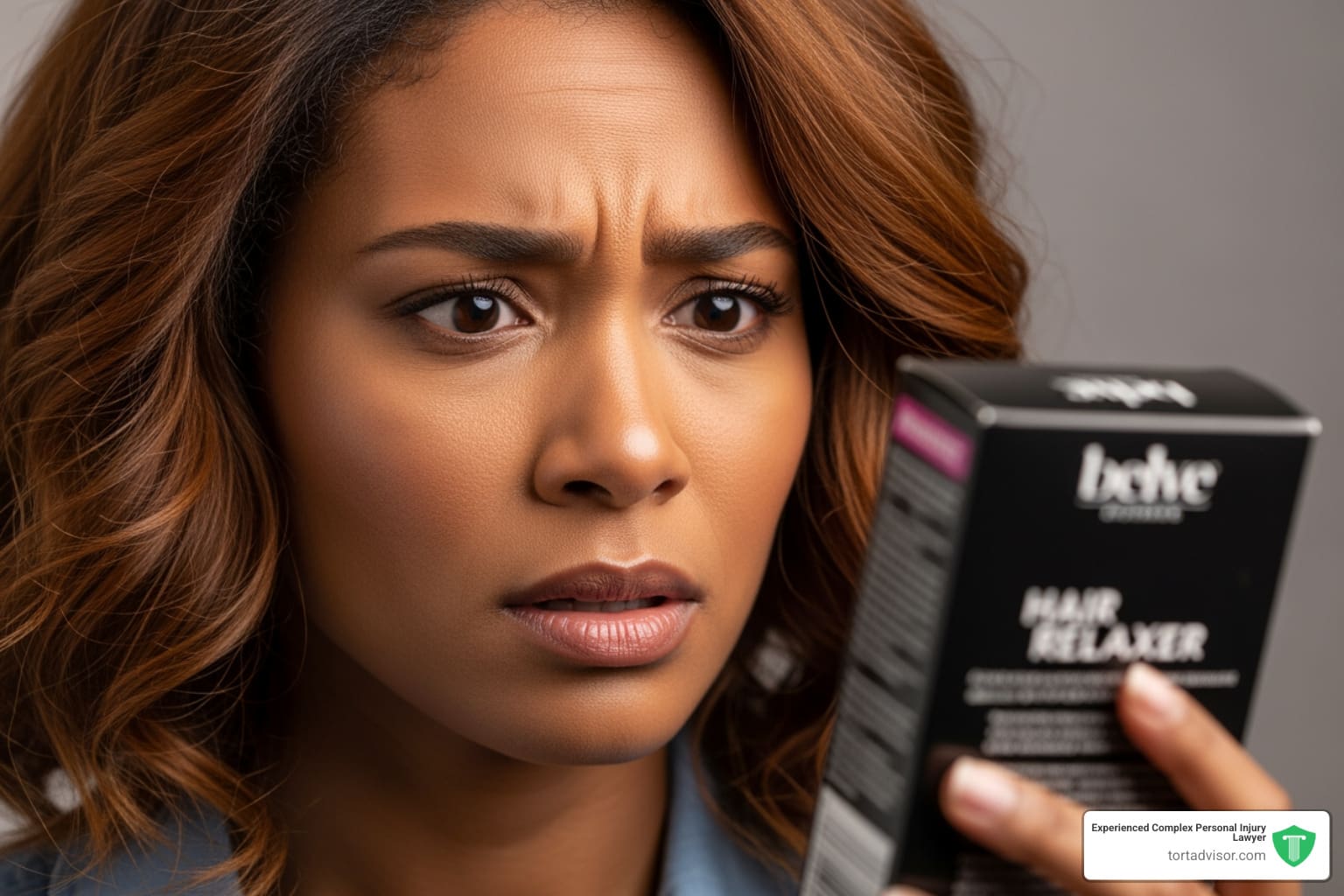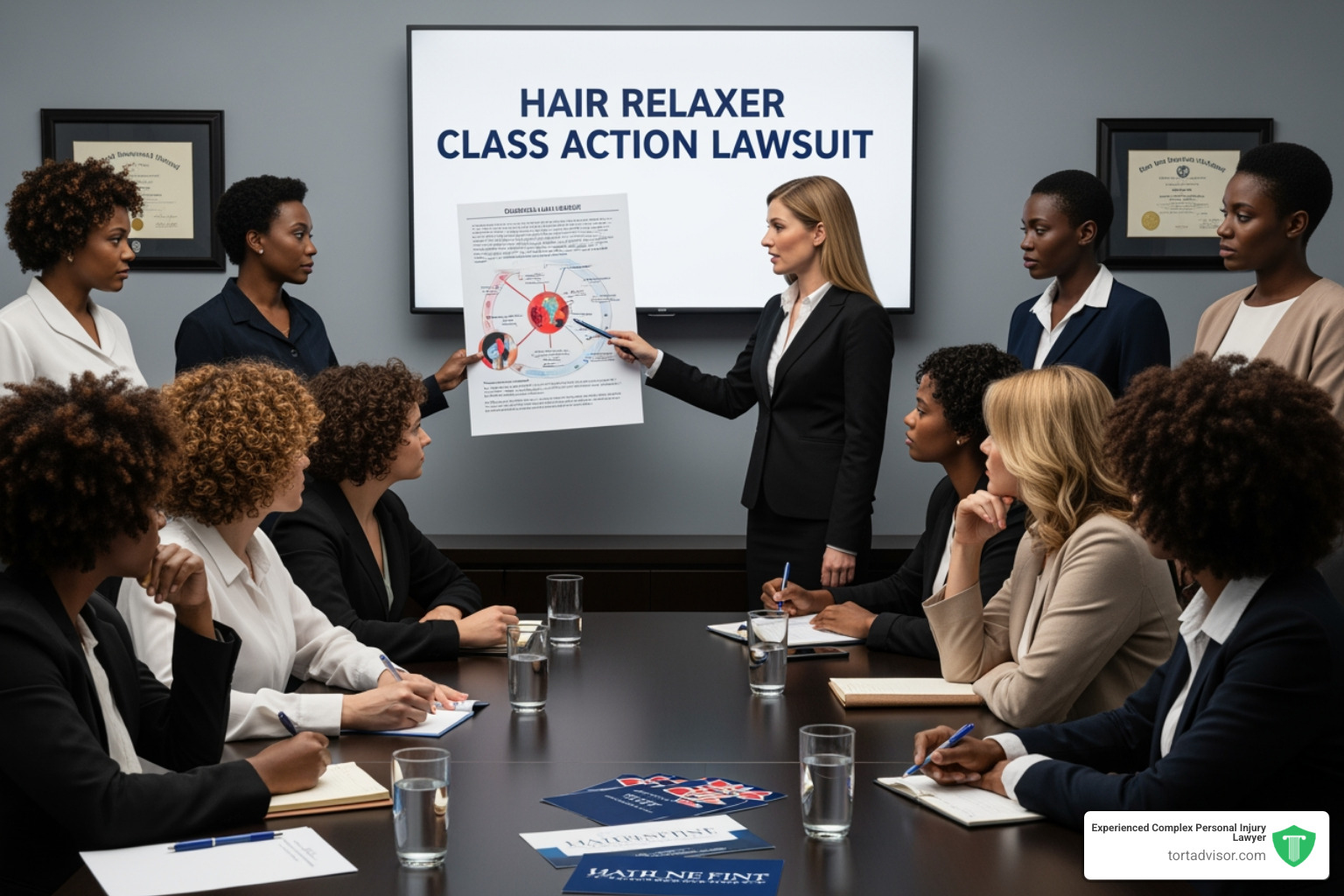


The Science Behind the Allegations: Linking Hair Relaxers to Cancer
#
The hair relaxer class action lawsuit is a major legal action in the United States, where thousands of women claim chemical hair straighteners caused serious health issues, including cancer. Here is a quick overview:
- What it is: A consolidated legal proceeding (Multidistrict Litigation, or MDL) against manufacturers of chemical hair relaxers.
- Main Allegations: Manufacturers knew their products contained harmful chemicals, failed to warn consumers, and engaged in predatory marketing.
- Key Health Issues Alleged: Uterine cancer, ovarian cancer, endometrial cancer, and uterine fibroids.
- Affected Group: Primarily Black women, who have historically been the main users of these products.
- Current Status: Over 10,000 cases are pending in an MDL in Illinois. The litigation is in its early stages, with bellwether trials expected in 2027.
This litigation gained momentum after a significant NIH Sister Study in October 2022 revealed a strong link between frequent hair relaxer use and an increased risk of uterine cancer. The lawsuits allege that companies knowingly sold dangerous products, often marketing them with misleading claims like “natural” or “gentle.”
For years, hair relaxers have been a staple for many, particularly Black women. These products permanently straighten hair by breaking down its natural curl pattern. However, the powerful chemicals used are now at the center of a massive legal challenge.
The core of the lawsuit rests on scientific evidence linking these products to serious health issues. The culprits are identified as endocrine-disrupting chemicals (EDCs), phthalates, parabens, and formaldehyde-releasing agents. These substances can be absorbed through the scalp, especially if it has burns or irritation—a common side effect of relaxers. Once absorbed, these chemicals can disrupt the body’s hormonal balance.
What Cancers Are Linked to Hair Relaxers?
The most commonly cited cancers in the lawsuits are:
- Uterine Cancer (including Endometrial Cancer): A groundbreaking 2022 NIH study found that women using hair relaxers over four times a year were more than twice as likely to develop uterine cancer. The risk by age 70 jumped from 1.64% for non-users to 4.05% for frequent users. Boston University’s Black Women’s Health Study reinforced this, finding postmenopausal women who frequently used relaxers for over five years had a more than 50% increased risk of uterine cancer. Tragically, Black women suffer from higher rates of aggressive uterine cancer and are nearly twice as likely to die from it compared to non-Hispanic white women.
- Ovarian Cancer: A 2021 NIH-funded study linked frequent use of hair relaxers (four or more times per year) to a 50% increased risk of developing this aggressive cancer.
- Uterine Fibroids: While not cancer, uterine fibroids are often cited in these lawsuits, especially if they required a hysterectomy. Research has found a potential link between hair relaxers and uterine fibroids in African American women.
You can read more about the scientific research on hair straighteners and uterine cancer directly from the National Institutes of Health.
How Do These Chemicals Cause Harm?
Harmful chemicals are absorbed through the scalp, which is often irritated or burned during the relaxing process. This damage creates pathways for chemicals to enter the bloodstream. The common “tingling or burning” sensation during application is a sign of chemical irritation that facilitates this absorption.
Once in the body, chemicals like phthalates and parabens act as endocrine-disrupting chemicals (EDCs). EDCs interfere with the endocrine system (glands like the ovaries and thyroid) by mimicking or disrupting natural hormones like estrogen. This hormonal imbalance is a key factor in developing hormone-sensitive cancers like uterine and ovarian cancer. For a deeper understanding, you can refer to the consensus on endocrine-disrupting chemicals.
One specific phthalate, Di(2-ethylhexyl)phthalate (DEHP), is frequently cited and is known to cause cancer and birth defects. Formaldehyde, another chemical proposed for an FDA ban in hair relaxers, is also a known carcinogen. Plaintiffs allege that consistent, long-term exposure to these chemicals has led to their devastating health outcomes.
An Inside Look at the Hair Relaxer Class Action Lawsuit
Federal lawsuits concerning injuries from hair relaxers have been consolidated into a multidistrict litigation (MDL), known as MDL No. 3060. This proceeding, officially titled “In RE: Hair Relaxer Marketing, Sales Practices, And Products Liability Litigation,” is overseen by Judge Mary Rowland in the U.S. District Court for the Northern District of Illinois.
The lawsuits center on several key allegations against the manufacturers:
- Predatory Marketing: Manufacturers allegedly targeted Black women and young girls with ads promoting Eurocentric beauty standards. These campaigns used misleading terms like “natural” or “gentle” to imply safety while hiding the presence of harmful chemicals.
- Failure to Warn: Companies knew or should have known about the serious health risks associated with their products but failed to provide adequate warnings, preventing consumers from making informed decisions.
- Defective Product Design: The products are alleged to be defectively designed because they contained dangerous chemicals that posed an unreasonable risk to consumers, especially with long-term use.
As of September 15, 2025, there are 10,858 lawsuits pending in the Hair Relaxer MDL, making it one of the largest active product liability cases. The number has grown significantly since the MDL was formed, highlighting the widespread impact of these products. If you’re curious to learn more about how these kinds of cases work, we have more info about defective product lawsuits available on our site.
Which Companies and Products Are Named in the Hair Relaxer Class Action Lawsuit?
The lawsuit names some of the biggest companies in the beauty industry, whose products have been on the market for decades. You might recognize names like:
- L’Oréal USA, Inc. and its partner SoftSheen-Carson LLC, known for brands such as Dark & Lovely and Optimum.
- Revlon, Inc. and Revlon Consumer Products Corporation.
- Strength of Nature Global, LLC, maker of Motions and Just for Me.
- Namaste Laboratories, LLC, associated with ORS Olive Oil relaxer products.
Other manufacturers named include Godrej SON Holdings, Inc., Dabur International Ltd., Dermoviva Skin Essentials, Inc., AFAM Concept, Inc. d/b/a JF Labs, Inc., Parfums de Coeur, Ltd. d/b/a PDC Brands, McBride Research Laboratories, Inc., Avlon Industries, Beauty Bell Enterprises, LLC d/b/a House of Cheatham, Inc., Luster Products, Inc., and Sally Beauty Holdings, Inc. d/b/a Silk Elements.
Many of these companies have sold relaxers for decades, with some products dating back to the 1950s. The lawsuits allege that manufacturers continued selling these products despite mounting scientific evidence of their dangers.
Why the Hair Relaxer Class Action Lawsuit Disproportionately Affects Black Women
The lawsuit has a deeply personal and historical dimension, disproportionately impacting Black women for several reasons:
- Targeted Marketing and Societal Pressure: For generations, companies have marketed hair relaxers heavily to Black women, often exploiting societal pressures and Eurocentric beauty standards that favor straight hair. Products like “Just for Me” targeted young Black girls, creating lifelong users. The lawsuit’s Master Complaint details this history, linking it to hair discrimination dating back to slavery and laws like Louisiana’s Tignon Law, which regulated Black women’s hair.
- Higher Usage Rates: Due to these marketing tactics and societal pressures, Black women have been the primary and most frequent users of chemical hair relaxers. In the NIH Sister Study, about 60% of participants who reported using relaxers were Black women. This has led to greater and more prolonged exposure to the potentially harmful chemicals.
- Health Disparities: Tragically, Black women not only used these products more but also face higher rates of aggressive uterine cancer. They are nearly twice as likely to die from the disease compared to non-Hispanic white women. This combination of targeted marketing, high usage, and severe health outcomes highlights the profound impact on the Black community.
The allegations suggest manufacturers knowingly capitalized on these societal pressures, prioritizing profits over the health of their most loyal customers.
The Legal Battle: Timelines, Challenges, and Potential Outcomes
Mass tort cases like the hair relaxer class action lawsuit follow a structured legal process to manage thousands of individual claims. This multidistrict litigation (MDL) is currently in the discovery phase, where information is exchanged, expert testimony is prepared, and procedural motions are filed.
What Is the Timeline for the Lawsuits?
The MDL was created in February 2023, consolidating dozens of lawsuits into one federal court. The timeline includes several key stages:
- Growing Caseload: The MDL began with around 60 cases and has since swelled to 10,858 pending lawsuits as of September 15, 2025, highlighting the massive scale of the litigation.
- Discovery Phase: The litigation is currently in the discovery phase, where both sides exchange information and documents. Expert discovery is expected to conclude by October 2026.
- “Science Day”: Scheduled for January 2026, this is a non-adversarial hearing where experts from both sides will educate Judge Rowland on the scientific evidence linking hair relaxers to health issues, helping the court understand the science before trials.
- Bellwether Trials on the Horizon: The next critical step is selecting bellwether cases. From an initial pool of 32 cases chosen in May 2025, a few representative cases will be selected for the first trials, expected in early 2027. These “test cases” are crucial as their outcomes can predict how juries might react to the evidence, heavily influencing settlement negotiations.
- Potential Settlement Talks: While no global settlement has been reached, the bellwether trial stage often prompts serious settlement discussions. Large jury verdicts in these early trials could pressure defendants to negotiate settlements for the entire MDL.
What Compensation Could Victims Receive?
Victims who successfully prove their claims may be entitled to significant compensation for the harms and losses they have suffered:
- Economic Damages: These cover measurable financial losses.
- Medical Bills: Compensation for past and future medical expenses, including hospital stays, surgeries, chemotherapy, medication, and ongoing care.
- Lost Income: Wages lost due to illness, inability to work, or reduced earning capacity.
- Non-Economic Damages: These cover intangible losses and are often a large part of the compensation.
- Pain and Suffering: For the physical pain, emotional distress, and overall impact on quality of life.
- Loss of Consortium: For the impact the injury has had on family relationships.
- Disfigurement: For physical changes resulting from extensive surgeries.
- Punitive Damages: Juries may award these damages to punish companies for extreme recklessness or malicious intent and to deter similar conduct in the future.
While no settlements or verdicts have occurred yet, attorneys have projected potential settlement values based on injury severity:
| Injury Type | Estimated Settlement Range (Individual Cases) |
|---|---|
| Uterine Cancer (Under 35) | $250,000 – $1,000,000 |
| Uterine Cancer (Over 50) | $250,000 – $500,000 |
| Endometrial Cancer | $200,000 – $450,000 |
| Fibroids with Hysterectomy (Under 40) | $90,000 – $150,000 |
| Fibroids without Surgery | $10,000 – $75,000 |
(Please note: These are just estimates based on similar past mass tort cases and legal analysis. The actual outcomes can vary significantly.)
For a more personalized estimate, you can use our Hair Relaxer Settlement Calculator.
What Are the Defendants’ Arguments and Legal Problems?
Manufacturers like L’Oréal and Revlon are fiercely contesting the claims with several key arguments:
- Denying a Scientific Link: Companies have publicly stated they “do not believe the science supports a link between chemical hair straighteners or relaxers and cancer,” arguing the evidence is inconclusive.
- Statute of Limitations and Repose: Defendants argue that some claims are barred by the statute of limitations, a deadline for filing lawsuits. However, the “discovery rule” often applies, meaning the deadline starts when a person discovered (or should have discovered) their injury and its cause. For many, this was after the October 2022 NIH study. Stricter “statutes of repose” in some states, like Georgia, pose an additional challenge, setting an absolute time limit regardless of when the injury was discovered.
- Jurisdictional Issues: Defendants have challenged the court’s jurisdiction. For example, L’Oréal S.A. (the French parent company) and Walgreens were dismissed from the MDL because plaintiffs could not establish a sufficient connection to the court’s jurisdiction.
- Lack of Specific Causation: Defendants may argue it is difficult to prove their specific product caused an illness, as many women use multiple hair products over their lifetime.
Despite these defenses, plaintiffs’ attorneys are confident. Judge Rowland has denied many motions to dismiss, affirming the validity of the claims and noting that defendants should have known about the risks of EDCs. This case draws comparisons to the Monsanto/Roundup litigation, where juries awarded substantial damages for failure to warn. Similar outcomes are possible here if plaintiffs prove manufacturers knowingly hid the risks. Understanding your rights is crucial; learn more about Product Liability Personal Injury on our website.
Frequently Asked Questions about Hair Relaxer Lawsuits
Here are answers to some common questions about the hair relaxer class action lawsuit.
Who is eligible to file a hair relaxer lawsuit?
Generally, you may be eligible to file a lawsuit if you meet these criteria:
- A history of regular and consistent use of chemical hair relaxer or straightening products over several years.
- A diagnosis of uterine cancer, ovarian cancer, or endometrial cancer that occurred after you began using hair relaxers.
- In some cases, a diagnosis of uterine fibroids that required surgery, such as a hysterectomy.
- Medical documentation of your diagnosis and treatment history.
Our team reviews cases across all 50 states, including our local areas like Chicago, Fort Lauderdale, and Miami. We encourage you to reach out for a free evaluation to see if you have a viable claim.
What is the difference between an MDL and a class action?
While often called a “class action,” the hair relaxer litigation is technically a Multidistrict Litigation (MDL). The two are different:
- An MDL consolidates thousands of individual lawsuits from across the country into one federal court (in this case, the Northern District of Illinois) for pre-trial proceedings like evidence gathering. This streamlines the process. However, each plaintiff retains their own individual lawsuit. If a case doesn’t settle, it can return to its original court for trial.
- A true class action involves a single lawsuit filed on behalf of a large group (a “class”). Any settlement or verdict applies to the entire class, and the compensation is divided among all members.
The MDL structure is used for the hair relaxer cases to efficiently manage the claims while preserving each person’s individual case.
How much does it cost to file a hair relaxer lawsuit?
Filing a lawsuit shouldn’t be a financial burden. We operate on a contingency fee basis, which means:
- You pay no upfront fees or out-of-pocket costs to start your case.
- Our attorneys are only paid if we win a settlement or verdict for you. Our fee is a percentage of the compensation recovered.
- If we don’t win your case, you owe us nothing.
We also offer a completely free, no-obligation case evaluation so you can explore your legal options without any financial pressure. This ensures everyone has access to experienced and dedicated legal representation.
Navigating Your Legal Options and Seeking Justice
The hair relaxer class action lawsuit is a pivotal moment for the beauty industry. With over 10,000 cases filed, this litigation forces manufacturers to answer for decades of alleged aggressive marketing and concealment of health risks. The impact is already visible, with the FDA proposing a ban on formaldehyde in hair relaxers—a direct acknowledgment of the dangers victims have highlighted.
However, regulatory change isn’t enough. These lawsuits aim to hold companies accountable, securing compensation for women who have suffered from cancer and other serious health issues. The goal extends beyond financial recovery to demand transparency, safer products, and an end to predatory marketing that has long targeted vulnerable communities.
Consumer awareness is growing, but many women used these products for decades, misled by marketing claims of “gentle” or “natural” formulas. Armed with knowledge from recent scientific studies, consumers can now make more informed choices about their health.
At Tort Advisor, we understand how devastating a cancer diagnosis can be, especially when it may have been preventable. You are not alone, and you have options. We connect clients with highly skilled attorneys specializing in complex product liability cases. Our network of attorneys is reviewing hair relaxer cases across all 50 states, including our local communities in Florida, Illinois, and New Jersey. They are prepared to fight for the justice you deserve.
The legal process can seem daunting, but our partners work on a contingency basis—you pay nothing unless they win your case. Your initial case evaluation is free, confidential, and carries no obligation.
By taking action, you are not only seeking compensation for your suffering but also holding an industry accountable and protecting future generations. If you or a loved one used chemical hair relaxers and were later diagnosed with uterine cancer, ovarian cancer, endometrial cancer, or uterine fibroids requiring surgery, we urge you to seek legal advice.
You deserve answers and accountability. Let us help you take the first step. Learn more about Hair Relaxer Lawsuits and how we can guide you through this process.
Free Confidential Case Evaluation
Complete the short form below to get an immediate FREE case review with an expert in your specific claim. Don't wait, your case could be time sensitive to file a claim.
Related Posts
Did a North Dakota product cause harm? Understand product liability, your rights, and how to take action for defects.
Get justice for clergy abuse. Find an expert Priest abuse lawyer to navigate complex laws and hold institutions accountable.
Diagnosed with meningioma after Depo-Provera? Understand potential Depo-Provera lawsuit settlements, risks, & how to claim compensation.
Uncover the truth about uber sexual assault cases. Learn about the alarming scale, Uber's accountability, and legal options for justice.
Facing wildfire losses? Discover the best wildfire lawsuit attorneys in California to fight for your full recovery and justice.
Exposed to Roundup & diagnosed with NHL? Discover how to sue Monsanto, understand eligibility, & seek compensation. Your guide to justice.










